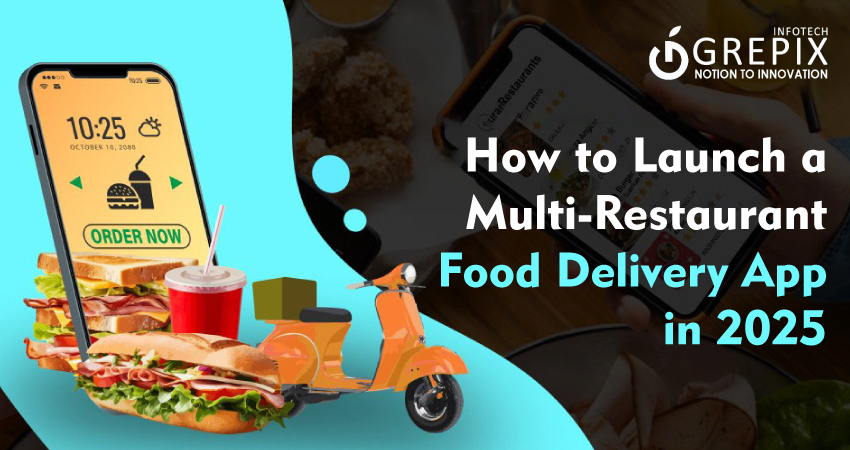How to Launch a Multi-Restaurant Food Delivery App in 2025
Launching a multi-restaurant food delivery app in 2025 requires strategic planning, technical savvy, and a deep understanding of market demands. This comprehensive guide reveals how to build a leading multi-restaurant food app, leverage food delivery clone solutions, and outpace DoorDash alternatives.
The rise of multi-restaurant food apps has changed how diners connect with their favorite restaurants, boosting choices and convenience. In 2025, creators invest in robust order management, seamless vendor onboarding, and advanced AI personalization to drive user engagement and business profitability. Food delivery clone scripts and DoorDash alternative models empower fast market entry and scalable growth. This guide explores multi-vendor models, restaurant onboarding, core features, and FAQs, helping entrepreneurs navigate the competitive food delivery landscape efficiently.
1The Multi-Vendor Model for Food Delivery
A multi-restaurant food app, also known as a food delivery clone or DoorDash alternative, supports multiple vendors and cuisines within a single platform. This model is ideal for marketplaces aiming to aggregate local restaurants and offer diverse choices to users.
Business Models
- Aggregator Model: The app lists partner restaurants, with restaurants handling own deliveries.
- Logistics-Supported Model: The platform manages both restaurant listings and delivery logistics, increasing reliability and user satisfaction.
Example Platforms
- Delivery: Operates a logistics-driven model, employing riders and managing deliveries for restaurants without their own fleet.
- Deonde Express: Offers SaaS-based multi-restaurant solutions, allowing entrepreneurs to scale quickly and on-board vendors efficiently
2Restaurant Onboarding: The Engine of Growth
Restaurant onboarding is the process by which eateries join the multi-restaurant food app ecosystem. Efficient onboarding streamlines menu setup, payment integration, and order management.
Steps to Onboard Restaurants
- Vendor Registration: Create a business account, sign partnership agreement.
- Menu Upload: Digitally submit menu items, photos, and pricing.
- Payment Integration: Connect POS and preferred payment gateways (Stripe, PayPal, etc.).
- Order Management Setup: Enable notifications, kitchen-specific routing, and real-time status updates.
- Brand Customization: Restaurants adjust their profiles, promotions, and seasonal offers.
Onboarding Features That Drive Success
- Automated onboarding workflows reduce manual labor.
- In-app chat, call, and review features strengthen vendor relationships.
- AI-powered recommendations adapt menus to user trends and optimize sales.
3Advanced Order Management for Multi-Restaurant Food Apps
Robust order management is critical for high-volume food delivery clone platforms and DoorDash alternatives.
Core Order Management Features
- Real-Time Tracking: GPS lets customers and restaurants follow orders from kitchen to doorstep.
- Order Pooling: Enables users to combine orders, sharing delivery fees for efficiency and sustainability.
- Photo Verification: Delivery agents upload order images, improving accuracy and trust.
- Automated Status Alerts: Push notifications update users about order progress and ETA.
- Contactless & Scheduled Delivery: Users choose drop-off modes, schedule orders in advance, or select pick-up options for flexibility.
AI & Machine Learning
- AI-Powered Routing: Real-time traffic and weather analysis minimize delays, maximizing delivery capacity.
- Personalized Menus: Show customized food options and deals based on user preferences.
- Fraud Monitoring: ML tools reduce errors and fraudulent transactions, boosting platform reliability.
Also Read: "Cloud Kitchens and Food Delivery Apps: A Perfect Match"
4Building a Food Delivery Clone Script or DoorDash Alternative
Food delivery clone scripts provide entrepreneurs a turnkey solution for quickly launching a multi-restaurant food app. These platforms are customizable, scalable, and often available as SaaS or with open-source code.
Benefits of Food Delivery Clone Solutions
- Fast Launch: Deploy your app in under a week using proven templates.
- Custom Branding: White-label options ensure your brand remains front and center.
- Pre-Built Admin Dashboards: Start managing orders, vendors, and analytics from day one.
- API Integrations: Seamlessly connect with POS, CRM, loyalty rewards, delivery tracking, and more.
Selecting a Clone Script
Consider scalability, feature set, UI/UX quality, and vendor support before purchasing a food delivery clone or developing a DoorDash alternative. StackFood and RebuEats are known for robust multi-platform solutions.
5 Essential Features for a Multi-Restaurant Food App
Multi-restaurant food apps require comprehensive, user-centric features to compete with leading DoorDash alternatives.
User Features
- In-app search and dish suggestion.
- Real-time order tracking and live updates.
- Personalized recommendations powered by AI.
- Contactless and scheduled delivery.
- Order pooling and pick-up options.
- Secure payment via cards, wallets, UPI, and COD.
Restaurant/Vendor Features
- Menu management and seasonal updates.
- Analytics dashboard for sales and order tracking.
- Promotions, discounts, and loyalty programs.
Delivery Agent Features
- Route optimization and incentives.
- Photo verification and two-way communication.
Admin Features
- Order management across vendors and zones.
- Commission and payout management.
- Fraud prevention and monitoring.
Trending Features for 2025
- Voice/chatbot ordering (AI chatbots).
- Subscription-based delivery plans.
- Group ordering and shared delivery.
- Real-time kitchen inventory syncing.
6Market Trends Driving Multi-Restaurant Food Apps
- AI Personalization: 80% of Gen Z consumers expect real-time order tracking and AI-based meal suggestions.
- Mobile-First Ordering: Over 67% of food orders originate from restaurant-owned apps or websites, not aggregators.
- Boom in Multi-Vendor Models: SaaS-based food delivery clone solutions make onboarding and scaling easier for new entrants.
- Growth in Subscription & Loyalty: Membership plans (like "Postmates Plus") foster repeat orders and customer retention.
7Roadmap: Launching Your Multi-Restaurant Food Delivery App in 2025
- Market Research: Analyze local demand, competition, and trending cuisines.
- Choose Your Model: Aggregator, logistics-supported, or hybrid.
- Select Your Tech Stack or Clone Script: Ensure scalability and rapid deployment.
- Create Vendor Onboarding Workflows: Design easy restaurant registration, integration, and menu mapping.
- Build User & Delivery Features: Real-time tracking, reviews, AI recommendations.
- Implement Secure Payment Gateways: Offer many payment options, including digital wallets.
- Test & Refine: Pilot launch with select vendors and neighborhoods.
- Launch & Scale: Roll out app marketing, onboarding waves, and expand delivery zones.
8Top Multi-Restaurant Food App Solutions (2025)
| App/Script | Model | Notable Features | Onboarding Speed | Scalability |
|---|---|---|---|---|
| Deonde Express | SaaS clone | GPS tracking, reviews, in-app chat | <7 days | High |
| StackFood | Multi-platform | Admin dashboard, loyalty | <10 days | High |
| RebuEats | White-label | Inventory management, mobile apps | <14 days | High |
| Deliveroo | Logistics-supported | Rider network, menu curation | <1 month | High |
Conclusion
Building a successful multi-restaurant food app is the key to tapping into the explosive food delivery market of 2025. Whether using a food delivery clone script or creating a DoorDash alternative, rapid onboarding, robust order management, and advanced AI features are essential for competitiveness, scalability, and profitability. Multi-vendor models empower entrepreneurs to aggregate diverse restaurant offerings and provide users with unmatched choice and convenience. As mobile-first ordering and personalization trends continue to grow, now is the time to seize the opportunity. Start planning, leverage clone solutions for rapid deployment, and build a brand that delivers exceptional dining experiences. Share this guide to empower others and step confidently into the future of food delivery
FAQs
1. What is a multi-restaurant food app and how does it differ from a single-restaurant app?
A multi-restaurant food app aggregates multiple eateries within one platform, enabling users to browse, order, and pay from diverse vendors unlike single-brand apps, which service just one restaurant.
2. How quickly can I launch a food delivery clone or DoorDash alternative?
With SaaS-based clone solutions, your app can go live in as little as 7 days after vendor onboarding and branding.
3. Which features are mission-critical for multi-restaurant food apps in 2025?
Real-time tracking, AI recommendations, secure payments, contactless delivery, order pooling, menu management, and analytics dashboards are essential.
4. What are the benefits of onboarding restaurants efficiently?
Fast onboarding boosts selection, order volume, and vendor loyalty, while automated workflows and in-app communication minimize manual support needs.
5. Can I launch a multi-restaurant food app without technical expertise?
Absolutely. Modern food delivery clone scripts and white-label platforms handle technical complexity, letting entrepreneurs focus on business growth and relationship building.
Launch your vision with our mobile app development company, where innovation meets excellence to create cutting edge mobile solutions.







